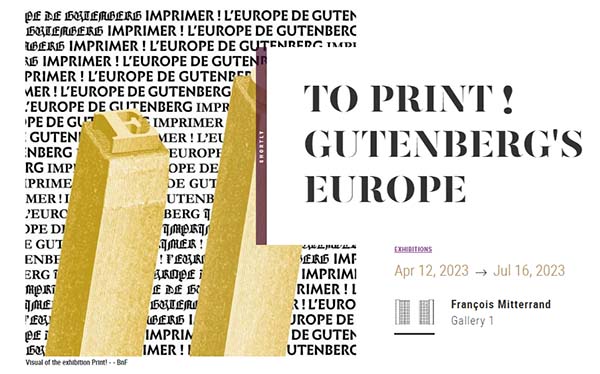프랑스국립도서관 '직지심체요절' 전시 TO PRINT ! GUTENBERG'S EUROPE'(4/12-7/16)
프랑스 국립도서관(Bibliothèque Nationale de France)이 오는 4월 12일부터 7월 16일까지 여는 '인쇄하다! 구텐베르크의 유럽(Imprimer! L'Europe de Gutenberg)' 전시에서 세계 최초 금속활자본 '백운화상초록불조직지심체요절'(직지심체요절·직지)을 50년만에 전시한다. 직시심체요절은 1377년 고려 우왕 때 청주 흥덕사에서 인쇄한 금속활자본으로 유렵 최초의 금속활자본 '구텐베르크 성경(1445년) 이전에 만들어졌다.
https://www.bnf.fr/fr/agenda/imprimer-leurope-de-gutenberg

TO PRINT ! GUTENBERG'S EUROPE
Apr 12, 2023 Until Jul 16, 2023
Bibliothèque nationale de France, François Mitterrand Gallery 1
In the middle of the 15th century , the whole of Europe discovered a technique for reproducing books that would disrupt their distribution and modify access to knowledge: the printing press. The BnF looks back on this innovation, one of the most striking of humanity, by retracing the history of the development of the printing press and the keys to its success. On this occasion are presented, for the first time simultaneously, exceptional pieces from the collections of the BnF: the oldest known western woodcut, the Bois Protat (France, around 1370 - 1380), the oldest preserved work in the printed world from metallic typefaces, the Jikji (Korea, 1377), and the first large European typographical print: the Gutenberg Bible (Germany, around 1455).
THE EXHIBITION IN DETAIL
The invention of printing
The invention of the printing press is perceived as a fundamental historical break, marking the entry into modernity. This event is often reduced to a single fact: the printing in Mainz around 1455, by the German Johann Gutenberg of a 42-line Bible.
The exhibition wishes to put the invention developed by Gutenberg in its context by specifying in particular that printing methods existed before. In China or Korea, xylography has been practiced since the 8th century .century and it is from Korea, with the Jikji, that comes the oldest preserved work printed with metallic movable type, according to a process very similar to that implemented in Mainz more than seventy years later. If Gutenberg was probably not aware of this Korean invention, he can rely on techniques and practices that also existed in Europe, where we know how to print and reproduce the image from around 1400 to the using an engraved matrix, first on wood, then on copper. The need for the multiple in order to allow wide distribution is also a problem that occupies the metal craftsmen, whom Gutenberg rubbed shoulders with during his stay in Strasbourg. His innovation was not only to combine three pre-existing techniques in the metal arts and the graphic arts – striking,
In the wake of Gutenberg, printers, humanists and artists have taken hold of his process, causing an unprecedented experimental proliferation. The rapid development of the printing press also guaranteed the printers of the 15th century great efficiency.
With nearly 270 pieces, witnesses of these trial and error techniques and experiments, the exhibition aims to show the prowess and advances made possible by this new process by following the book manufacturing process, from the printer's workshop to the stall of the bookseller, from the craftsman to the reader, emphasizing its collective dimension. The typography workshops of the 15th century were veritable laboratories for experimentation, making it possible to overcome certain technical difficulties and favoring the spread of printing processes throughout Europe. These techniques will be presented and explained in a space dedicated to the printer's workshop, organized around an exceptional press lent by the Gutenberg museum in Mainz.;
프랑스, 세계 최고 금속활자본 ‘직지’ 50년 만에 전시
국립도서관 ‘구텐베르크 성경’ 등, 4월 일반 공개…1973년 이후 처음
https://www.khan.co.kr/culture/culture-general/article/202302161228001




 아그네스 군드(Agnes Gund) DC내셔널갤러리 흑인작가 기금 1백만...
아그네스 군드(Agnes Gund) DC내셔널갤러리 흑인작가 기금 1백만...


-Elaine-